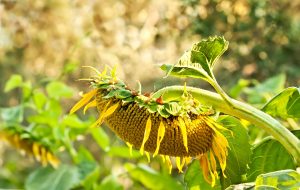Signs of Over or Under Watering in Plants
 Water is one of the main factors responsible for healthy and flourishing plants. However, it is important to provide your plants with the right amount of water. Watering your plants too much or too little are equally problematic and can result in a plant dying. Here are some of the common symptoms associated with over watering and under watering your plants:
Water is one of the main factors responsible for healthy and flourishing plants. However, it is important to provide your plants with the right amount of water. Watering your plants too much or too little are equally problematic and can result in a plant dying. Here are some of the common symptoms associated with over watering and under watering your plants:
How to Know Your Plants Need More Water
Here is what a plant that has not been watered may look like:
Wilted Leaves
A plant that has not being watered enough will have wilted and drooping leaves. This is because there isn’t enough of water passing through cells of the plant. When there is a lack of water, plants compensate by closing their stomata as a method of preventing moisture from escaping the plant. This is what causes the leaves to wilt.
Brown Leaves
After a while, the wilted leaves will begin to brown and may then begin to fall off. The browning of the leaves tend to start on the bottommost leaves. However, with bushier plants, this may begin on the outside. You can determine that the browning leaves are due to under watering if the leaves are crisp when you touch them.
Slow Growth
When there is not enough water, the plants will not grow as well as they are supposed to. This means that the plant will be much smaller than usual and even the leaves will not grow as much. If the water shortage is temporary, the plant will begin to grow again once it is watered properly. If it is permanent, the plant may cease growing entirely.
How to Know If You Are Watering Your Plants Too Much
Over watering a plant can be just as harmful as under-watering it. One way is by using a Moisture Meter. Other ways include:
Wilting or Brown Leaves
Yes, this happens when you overwater a plant as well. An excess of water in the soil prevents the water from being able to take in oxygen which is what can cause the leaves to wilt. To make sure that this is because of over watering, touch the soil. If it is wet to the touch, there is too much water.
Edemas
Sometimes, the excess of water present in the soil can cause the plant to absorb too much. This will often manifest in the form of edemas. When the cells take up so much water, they may be prone to rupturing. This will look like a bump or a lesion on the plant.
Root Rot
When there is too much water for the plant to absorb, it remains in the soil, causing flooding. When this happens, the roots can drown as they have limited access to air. Root rot will result in grey or brown roots that are slimy.
The best way to determine if your plants are getting the right amount of water is to test the soil. Simply push a finger into the soil. You should be able to easily break through the top layer. If it is too hard to do so, your plant needs water. However, if the soil is wet, you don’t need to water your plants for a while.
To learn more about vegetable gardening of various kinds, you should absolutely check out The MiniFarming Guide to Vegetable Gardening.

